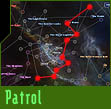 Patrol missions are imperative to local defense within a faction's sphere of influence. These missions are extremely straightforward, in that all you need to do is pass through a series of space locations. Once you have docked, the dock crew will make sure that your ship's flight recorder information is downloaded and sent to central command for processing. Patrol missions are imperative to local defense within a faction's sphere of influence. These missions are extremely straightforward, in that all you need to do is pass through a series of space locations. Once you have docked, the dock crew will make sure that your ship's flight recorder information is downloaded and sent to central command for processing.
A helpful resource for patrol missions is the in-flight map.
These missions can also be used in conjunction with personal cargo or beacon runs since they are so easy to complete.
| Combat Missions |
 Although TRI encourages peaceful conflict resolution, the protection of enlisted pilots comes before communication with the conflux. To date no method of communication has succeeded, which leaves no choice but to rip 'em and send them back whenceforth they came. Combat missions are often offensive in nature, and are by far the riskiest of all missions. Although TRI encourages peaceful conflict resolution, the protection of enlisted pilots comes before communication with the conflux. To date no method of communication has succeeded, which leaves no choice but to rip 'em and send them back whenceforth they came. Combat missions are often offensive in nature, and are by far the riskiest of all missions.
Once you have accepted a combat mission, you will need to locate and destroy a given number of conflux craft. Combat missions will usually pay better than expected, as each conflux kill will generate a bounty as well as an experience point bonus. |
| Scout Missions |
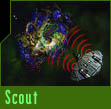 Scout missions are one of the more important missions available from TRI's perspective. These assignments, should you choose to accept them, provide TRI with much needed recon data about spatial anomalies and the like. Scout missions are one of the more important missions available from TRI's perspective. These assignments, should you choose to accept them, provide TRI with much needed recon data about spatial anomalies and the like.
On occasion, you may also receive scouting assignments from your faction, which often consist of snapping a few pictures or scans of an opposing faction's stations. These assignments can be especially risky if other pilots catch on to your intent. In fact, once your mission has been uncovered by enemy pilots, be prepared to face espionage charges (usually dispensed at point blank from the steaming barrel of a serializer.)
Before accepting a scout mission, you will want to make sure that you have purchased the necessary mission equipment. Depending on the mission, you will need either a camera or a scanner MODx equipped.
| Scanning Equipment
|
|
|

|
Solrain's standard data recording device can be configured to record any number of frequencies directly to an internal disc drive. |
|

|
Quantar's standard scanning device can record for several hours before the onboard hard drive must be wiped. |
|

|
Working on a slightly different system, the standard Octavian scanner pipes recorded data directly into the ship's main computer, giving virtually endless hours of recording time. | |
| Visual Recording Devices (Cameras)
|
|
|

|
The Solrain camera includes such features as automatic zoom and digital image compression. these cameras can be used on even the most invasive espionage missions. |
|

|
Quantar's VRD (visual recording device) is the most durable camera on the market. this device was used during the GVB wars, and over 80% of damaged cameras contained salvageable data. |
|

|
Although Octavian cameras are both bulky and somewhat low tech, they do serve their purpose. | | |
| T.R.I. Missions |
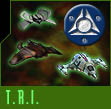 TRI often issues missions which will serve their interest (and supposedly everyone else's...) These missions range from keeping the conflux population down to running large loads of a particular commodity to a TRI certified production facility. TRI missions can be accepted from any station, and are universally uniform. TRI often issues missions which will serve their interest (and supposedly everyone else's...) These missions range from keeping the conflux population down to running large loads of a particular commodity to a TRI certified production facility. TRI missions can be accepted from any station, and are universally uniform.
|
| Faction Missions |
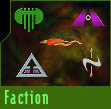 Faction missions are issued from each empire's home world, and provide specific objectives for their members. Faction missions, when completed, build specific buildings and other useful items for that sector, which adds varying benefits and abilities to the faction's station and or pilots. Faction missions are issued from each empire's home world, and provide specific objectives for their members. Faction missions, when completed, build specific buildings and other useful items for that sector, which adds varying benefits and abilities to the faction's station and or pilots.
|
|
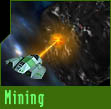 Mining is a good way of collecting raw materials without stripping a planet of its resources. Since each station is constantly consuming these materials, mining missions are always available and often pay very well.
Mining is a good way of collecting raw materials without stripping a planet of its resources. Since each station is constantly consuming these materials, mining missions are always available and often pay very well.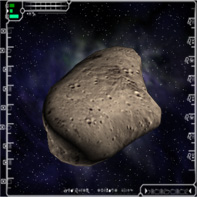
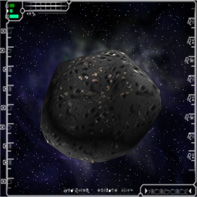
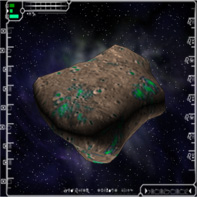
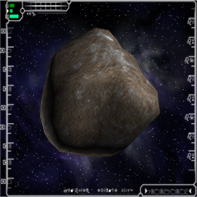
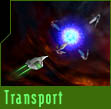 Transport missions are fairy simple missions. Once you accept a transport mission, a unique item will be loaded into your cargo bay. These items may contain sensitive data or equipment, such as weapons and equipment prototypes, sensitive data discs, or personal belongings.
Transport missions are fairy simple missions. Once you accept a transport mission, a unique item will be loaded into your cargo bay. These items may contain sensitive data or equipment, such as weapons and equipment prototypes, sensitive data discs, or personal belongings.


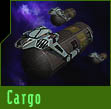 Cargo missions are slightly more advanced than transport missions. A station offers cargo missions when the supply of a particular commodity is low. To complete a cargo mission you will need to fly to a space station which stocks the particular item, purchase the specified quantity, and then return to the station of origin.
Cargo missions are slightly more advanced than transport missions. A station offers cargo missions when the supply of a particular commodity is low. To complete a cargo mission you will need to fly to a space station which stocks the particular item, purchase the specified quantity, and then return to the station of origin. Patrol missions are imperative to local defense within a faction's sphere of influence. These missions are extremely straightforward, in that all you need to do is pass through a series of space locations. Once you have docked, the dock crew will make sure that your ship's flight recorder information is downloaded and sent to central command for processing.
Patrol missions are imperative to local defense within a faction's sphere of influence. These missions are extremely straightforward, in that all you need to do is pass through a series of space locations. Once you have docked, the dock crew will make sure that your ship's flight recorder information is downloaded and sent to central command for processing. Although TRI encourages peaceful conflict resolution, the protection of enlisted pilots comes before communication with the
Although TRI encourages peaceful conflict resolution, the protection of enlisted pilots comes before communication with the  Scout missions are one of the more important missions available from TRI's perspective. These assignments, should you choose to accept them, provide TRI with much needed recon data about spatial anomalies and the like.
Scout missions are one of the more important missions available from TRI's perspective. These assignments, should you choose to accept them, provide TRI with much needed recon data about spatial anomalies and the like.





 TRI often issues missions which will serve their interest (and supposedly everyone else's...) These missions range from keeping the
TRI often issues missions which will serve their interest (and supposedly everyone else's...) These missions range from keeping the  Faction missions are issued from each empire's home world, and provide specific objectives for their members. Faction missions, when completed, build specific buildings and other useful items for that sector, which adds varying benefits and abilities to the faction's station and or pilots.
Faction missions are issued from each empire's home world, and provide specific objectives for their members. Faction missions, when completed, build specific buildings and other useful items for that sector, which adds varying benefits and abilities to the faction's station and or pilots.